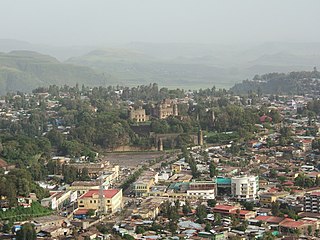
The politics of Ethiopia arise from the way the government of Ethiopia is structured as well as socioeconomic factors. The country's government is structured as a federal parliamentary republic with both a President and Prime Minister.

The government of Ethiopia is structured in a framework of a federal parliamentary republic, whereby the Prime Minister is the head of government. Executive power is exercised by the government. The prime minister is chosen by the parliament. Federal legislative power is vested in both the government and the two chambers of parliament. The Judiciary is more or less independent of the executive and the legislature. They are governed under the 1995 Constitution of Ethiopia. There is a bicameral parliament made of the 108-seat house of federation and the 547-seat House of Peoples Representatives. The house of federation has members chosen by the state assemblies to serve five year terms. The house of people's representatives are elected by direct election, who in turn elect the president for a six-year term.

At the federal level, Ethiopia elects a legislature. The Federal Parliamentary Assembly has two chambers: the Council of People's Representatives with not more than 550 members as per the constitution but actually nearly 547 members, elected for five-year terms in single-seat constituencies; and the Council of the Federation with 117 members, one each from the 22 minority nationalities, and one from each professional sector of its remaining nationalities, designated by the regional councils, which may elect them themselves or through popular elections.

Ethiopia held general elections on May 15, 2005, for seats in both its national House of Peoples' Representatives and in four regional government councils. Under pressure from the international community, Prime Minister Meles Zenawi promised that this election would be proof that more democracy would come in this multi-ethnic nation; international elections observers from the European Union (EU) and the U.S.-based Carter Center were present to observe the results. This election succeeded in attracting about 90% of the registered voters to the polls. A government ban on protests was imposed throughout the election period.
The Coalition for Unity and Democracy, commonly referred to by its English abbreviation CUD, or occasionally CDU; its Amharic abbreviation, used in Ethiopia, is Qinijit, in English writing often referred to as Kinijit) is a coalition of four existing political parties of Ethiopia which combined to compete for seats in the Ethiopian General Elections held on May 15, 2005. Its leader was Dr. Hailu Shawul.

The United Ethiopian Democratic Forces is a coalition of several political parties in Ethiopia which combined to compete for seats in the Ethiopian General Elections held on May 15, 2005.
Hailu Shawul was an Ethiopian prominent politician and Civil Engineer who was the leader of the Coalition for Unity and Democracy (CUD) during Ethiopian general election, 2005. He was also the leader of All Ethiopian Unity Party from 1996 to 2013. He died at age of 80 on October 6, 2016 while receiving treatment at a hospital in Bangkok, Thailand.

The Gambela Peoples’ Democratic Movement is a political party in the Gambela Region of Ethiopia. It is the regional ally of the ruling EPRDF coalition.

The Parliament of Ethiopia consists of two chambers:

The Islamic Front for Liberation of Oromia was an Oromo-based political and paramilitary organization founded in 1985 by its Commander in Chief, Sheikh Abdulkarim Ibrahim Hamid, otherwise known as Jaarraa Abbaa Gadaa.

Ethiopia held general elections on 14 May and 31 August 2000 for seats in both its national House of Peoples' Representatives and several regional government councils. Although several opposition parties boycotted the election, 17 parties including the All-Amhara People's Organization, the Southern Ethiopia Peoples' Democratic Coalition (SEPDC), and the Oromo National Congress did participate.

A parliamentary election was held in Ethiopia on May 23, 2010.

Elections for a Constituent Assembly were held in Ethiopia on 5 June 1994 in order to form a body to draw up a new constitution. They were the first elections after the overthrow of the Mengistu regime at the end of the Ethiopian Civil War in 1991, and the first ever multi-party elections in the country; previous elections had either been non-partisan or one-party. The results saw the Ethiopian People's Revolutionary Democratic Front and its allies win 463 of the 544 seats. Voter turnout was 87.5%.
The Commission for Organizing the Party of the Working People of Ethiopia, generally known by its English acronym COPWE, was a political organization in Ethiopia. COPWE was a preparty organization, it had the task of preparing the Ethiopian people for creation of a Communist Party. In the absence of a Communist Party, COPWE functioned as a temporary replacement of the party that it would create.

The premiership of Meles Zenawi began on August 1995 following the 1995 Ethiopian general election and ended upon his death on 20 August 2012. Whilst serving as Prime Minister of Ethiopia, Meles Zenawi concurrently served as the Leader of the Tigray People's Liberation Front (TPLF) and Ethiopian People's Revolutionary Democratic Front (EPRDF).
Parliamentary elections were held in Ethiopia on 24 May 2015 to elect officials to the House of Peoples' Representatives. Regional Assembly elections were also held on this date.











